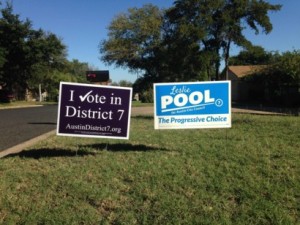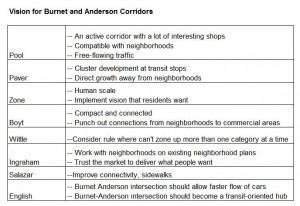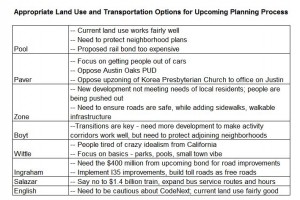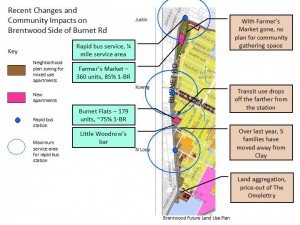This is the last of four interviews with City Council District 7 candidate Ed English on his candidacy and the issues identified in the AustinDistrict7.org candidate scorecard. The interviews are organized as follows:
* Top Priorities, Experience, Community Involvement
* Livability, Affordability and Housing
* Transportation, Open Space and Infrastructure
* Public Safety, Small Business, and City Budget
Residents in far north and northeast Austin have complained repeatedly about insufficient police resources. Crime in northeast Austin is like whack-a-mole, shifting from area to area in response to where police resources are currently focused. Yet police/fire/EMS is expensive, taking up 62% of the City’s operational budget. Any answers on these challenges?
I would support adding additional officers to the staff on a limited extent. Some people don’t support it, I do.
We’re blessed in the sense that Austin, given its size and make-up, has a fairly low crime rate. Now that’s citywide. We do have crime – everybody’s ultimately affected by additional bumps in their insurance rates and things like that. But at its most personal level, crime’s in your backyard, it’s in your driveway, it’s someone stealing your laptop from your car at Target. Crime for most people – it’s a very personal thing. And we have areas of the city that have issues. Certainly District 7 does in the north central, northeast. I think we need to address that.
We currently have an officer-to-citizen ratio that’s reasonable, let’s put it that way. It’s not quite in alignment with other cities. I understand that – we have more residents per officer than some of the other cities, but they have bigger crime rates. It’s a trade-off.
One of the costs that seems out of line to me is the amount of overtime that we pay our officers. Our officers are well paid, their current contract runs through 2017. Their pay rate is established for some time to come. But what does flex, and flex significantly, is what they have to spend in overtime. What I would like to see, and I don’t think it would take very long or be very extensive, is an analysis of how many officers we could add, if we were to dramatically reduce overtime – use the savings from overtime to pay for additional officers, and then put policies in place to make sure that workloads are sufficiently distributed with these additional officers that we don’t return to a situation where we’re paying officers overtime, all the time. I think we could add officers without adding more cost to the city.
A lot of land in District 7 subject to development or redevelopment is on flood plains subject to flash floods, or in areas subject to wildfires. Some suburban communities have only one or two evacuation routes in the event of a disaster. Climate trends could make these risks worse. But taking away property owner entitlements is always tricky. What tools, including land use requirements, should be considered?
I’m generally in favor of significant restrictions on building in flood-prone areas. Over several decades, and it’s not anyone’s fault, we had other priorities, we looked the other way, let a development go into a 50- or 100-year flood plain. It’s not right on the creek, we have bigger fish to fry. And then when we have something like the floods last Halloween, that lack of planning, those decisions come back to bite us big. It just doesn’t seem like in the past we’ve learned very much from those lessons, because we repeat the same mistakes. And then when the disaster happens, we say, “Why didn’t we do something long ago?” You’ve got to take the long-term view that the disasters when they come are so horrific and so expensive, the risk of loss of life can be so high, that you have to look at the consequences of the lack of restrictions.
We need to get out of the business of buying out homes in areas that were flooded. That’s the situation we’re facing right now with Onion Creek. It’s a very unhappy situation. I don’t know that there’s an all-right answer to that. I appreciate the terrible circumstances some of those homeowners are in, but I also understand the view of other people of, “Why should I pay for that expense for poor decisions made by people long ago?”
I was encouraged that the City did move forward with about $300,000 for a series of test wildfire sensors that they’re going to install. It’s a one to two year pilot project that, if it works, if it offers enough of an early alert beyond what we’d get with someone just calling it in… I’m financially a little frugal, but I think this was one of those cases where an ounce of prevention was worth a pound of cure.
I have a letter from the owner of Dan’s Hamburgers, a local small business, describing the pain and expense of doing a simple remodeling. Other small business people have complained about sky-rocketing utility rates or other forms of red tape. What are the top 3 things City Council can do to help small business?
I have run a small business, but not from a brick-and-mortars location. I would like to see us protect the small businesses here. And I’m not anti-big-box stores, I’m not anti-conglomerates. But I think we do what we can to encourage small businesses to both start here and stay here and flourish here.
At the top of the list is stream-lining the permitting process. I’ve heard complaints about a lot of things from small businesses, but nothing comes close to that. If the businesses had any need within recent years to do remodeling, expansions, opening up a second location, permitting is usually their chief complaint. And that process needs to be completely revisited and streamlined. Sadly, in a city that considers itself a techie town, so much of that process now is still manual. It’s amazing to me that other cities that surround us in the suburbs – have a large portion of their permitting process online. A lot of it is done by the time you get there. You’re in and out in an hour. It couldn’t be further from that here in Austin.
The way they’ve broken down the tiered structure for electrical rates, for a lot of small businesses, it’s double or triple what it was just a short time ago. For a small business, that’s a significant impact on their bottom line.
I’ll take a very recent example, which is unfolding, is this new concept of a transportation corridor adjacent to a neighborhood plan. You were at that meeting [a staff presentation on the Burnet Rd corridor plan process]. I think one of the things that jumped out, and I commend the gentleman – he made an incredibly valid point – where are the small business people? Why were they not encouraged to be part of this process? Where was the outreach to them? He made several points that you’d be hard pressed to argue with – you’re talking about changing a plan for a business corridor that would potentially, again it’s in the early phases, have a dramatic impact on small, long-term, family-oriented businesses that are along Burnet Rd. That type of oversight in soliciting impact at this early stage, we’ve seen those kinds of things before. It’s unfortunate that there was a classic case of one man in a room full of people standing up and pointing out the obvious – the incredibly obvious.
As that plan develops, if it goes forward, and it looks like it will, I think that a very core part of developing that transportation, and I call it transportation slash business corridor, is to look what you can do, as far as the provisions, code, regulations, to keep those businesses there. And not just there, but make sure they have an opportunity to flourish – that you don’t set something up that’s unreasonably restrictive. Those businesses add a lot of character to the neighborhoods.
9/21 – In summary, I would like to see the permitting process revised and streamlined, a review of the utility rate tier structure to restore a reasonable expense level on small businesses and the inclusion of small businesses in the decision making processes that will be part of CodeNext and/or any future corridor plans to ensure they are not significantly adversely affected.
So by unreasonably restrictive, what do you mean, what would be an example for a small mom or pop business along Burnet?
Parking’s always an issue, so let’s pick that as a topic. A lot of those businesses, a fair percentage, have fairly limited parking. They may have 2-3 employee spots in the back, enough for 4 customers up front. I would hate to see anything that would further reduce their parking.
Sign ordinances, that’s another issue. That’s more of an issue in some cities than it is here. I think on a corridor you want to make it look nice, make it a place people want to travel through, especially on mass transit. “Hey, this is a nice neighborhood – I might want to live here, I might want to shop here.” But at the same point, and I have seen this as I’ve traveled so much over the years, there can be overreach – you can only have a sign on your building and it has to be… if we’ve lived with the signs that those businesses have up to this point, and life hasn’t ended as we know it, then let’s don’t do something like, your sign is now one foot too wide, it doesn’t meet our beautification standards.
Local economist Brian Kelsey recently described Austin’s business incentives policies as wildly successful, contributing to a soft landing after the 2008 recession and robust growth since. Other commentators claim the policies favor big business and fuel gentrification. According to the City Budget, Austin has allocated about $43 million for FY 2014 in business development and incentives. Some of this goes to support local music and cultural assets, and to create blue collar jobs. Most of the $13.2 million in economic development funding targets a few strategic sectors: clean energy, biotech, digital media and wireless. Does Austin have the right economic development strategy?
Yes and no. You’re talking about a city, the eleventh largest city in the United States. There’s no one-size-fits-all here. The current and recent past approach worked at meeting the goals, the general direction of the city for a period of time.
But for me, and I think a lot of people, we need to revisit how we use incentives, when we use incentives, for what reason. Incentives that are used with the only justification that if we don’t offer them, they’ll go somewhere else, for me, that day is over. If that’s the only reason we offer an incentive, and they won’t come here anyway, fine – find another place to make your nest.
I am not totally against incentives. But I believe they should be used extremely sparingly. The core justification for an incentive package should be that it meets a need that’s currently not being met. If we are going to entice an employer to come here, it needs to offer something that we currently don’t have, or have enough of.
This is a favorite subject of mine, because I believe when we use those incentives sparingly, we put into them a few very key provisions. One, that the employers be geographically dispersed. That goes a long way toward keeping our traffic situation from getting worse. You place the location that’s as close as possible to the talent base, so again travel time is reduced. I also believe, and the mayor got put on the spot at an ANC meeting about two months ago. He was asked, “Do you believe that incentives have been sufficiently targeted to bring jobs to Austin that target more middle income people – $40-50k people, who might have a high school education, or an associate. Don’t necessarily have a master’s in software engineering. And his answer was no. And I would agree with him. I’d like to see an incentive here to accomplish, for instance, we bring an employer, we offer a reasonable incentive with measurable benchmarks. We put that employer in northeast Austin. That employer is of a nature that will offer employment to a section of Austin that badly needs it.
Fedex is opening a facility in Pflugerville, that meet a lot of the criteria. Why wasn’t that facility opened on our side of the city limits? To me that’s the fish that got away. Their truck traffic’s going to use 130, it won’t be on I35. It’s well located, drawing from a skill set that lives nearby.
Now the location is pretty close to where you would want it anyway. The big issue is that we lost the tax base…
That’s it. And it’s a great example of an incentive package that meets all the criteria I’d like to see.
I’d also like part of the incentive, where doable, to include an education package. Let’s say it is a technology job, but it’s primarily an assembly job, where you can have a large employer, but not a large group of employees, who just need enough education to qualify to take the position. I’d like to see incentives where possible include a training program for the employers and employees who live close, who are close to meeting the requirements anyway.
Assuming you were able to implement your policy goals, what structural changes could one expect in the City budget? Where would spending increase or decrease?
9/21 – One place to begin looking for opportunities to either increase or decrease spending is to start with a zero based budgeting process. This need not be done every year, but should be done on a periodic basis. Simply put, every department would need to justify all expenses, not simply carry an expense over from one year to the next without some explanation as to why it is necessary.
In addition, an outside audit with an eye toward finding wasteful, duplicate or uncoordinated spending (where the advantage of volume purchasing is lost) would, I believe, pinpoint areas where savings could be made and spending reduced. We also need to ask serious questions as to why so many unfilled city positions are being budgeted for each year. This money ends up being used for other purposes. As a city we need to be more transparent about where taxpayer dollars are actually being spent and properly budget for those expenditures up front.
Reducing the number of unfilled positions budgeted for offers some significant saving opportunities. These saving could be, where justified, used to increase or pay for spending in areas like restoring library hours, adding more paramedics and the like (these specific expenditure increases have recently been approved).
What I’m hearing from you is that you’re looking for ways to cut taxes and utility rates, to bring down the burden of living in Austin.
You would modestly increase police, but you would find off-setting mechanisms to cover that.
That’s correct.
Transportation is a really big expensive thing, that would increase. If you’re cutting livability, and increasing transportation, keeping police about the same, you mentioned increasing revenue, but as you’re adding housing, you’re also having to add infrastructure to support that. That sounds like a wash. It’s an unfair question, but what other changes would you expect on the budget? How would you keep it in balance?
And again, things are very fluid because we have a rapidly growing city. By the time the next budget process and work sessions come along, we’ll be in a different environment. You listen to the community, you find out where you think their priorities are, where they’d like to see increased spending. At the same time you have to ask the tough questions – if you had to cut spending, where would you cut it. That generally brings out a lot of unhappiness.
A lot of governmental agencies have this mindset that we have a guaranteed source of income. If we need more, we can just raise taxes, add fees. In private industry and personal life, that option’s not open. We look at what we can afford, and then we decide what we can buy. That’s a general focus of mine, that’s a general mindset of mine.
But businesses can also borrow to expand their business. If you’re a growing business..
To a point. Borrowing has its limits. Borrowing is part of operating the city government. It’s also part of running a business. Businesses don’t have a well that they can go to, until the well doesn’t want to pay anymore, at some point, bond agencies – you have a credit rating as a business, just like you do as a city. At some point in time, the banks say no, you have to start paying those bills. And your sources of new revenue are somewhat limited.
Sometimes, with a governmental mindset, you don’t see that. And I believe a lot of people in Austin would concur, that this tax well out there, the population is just an unending stream of revenue – we can just ask for more and more and more, and they’ll keep paying it. If ever there was a time when the city was being smacked about the head, that there is a pain threshold that people do not want you to cross, I firmly believe we’ve reached that.
I’m real happy that the city is doing some cross-coordination with the other taxing entities and working on an affordability index. I think that’s a first step in the right direction.
I think an initial target early on, is to freeze the budget in place. You have certain contractual obligations with the police, the fire fighters, EMS. There’s certain contractual obligations that require to spend more than the year before. You start from the base that, why does any department need any more than it needed the year before. It’s putting a level of justification on a department for its expenditures that hasn’t been there in the past. It’s not a fun process for city departments, department heads, to do a from scratch justification…
Any department is going to always have a list of rationales for why they want to spend money, and most of them are legitimate. At some point it’s going to come down to your subjective prioritization…
Absolutely. They all have things they want, that they need…
9/21 – Budgeting is always a combination of hard data on what revenues are available and the subjective judgment of those deciding on how it is to be allocated. That subjective judgment must always be rooted in an open and transparent citizen input process. From there, the members of the City Council must, with a sense of fairness, compromise, balance and fiscal responsibility, make the calls on which departments will get what.
And not just ‘they’. There are constituents, you say 80,000 people in the district, any one 10,000 of those people are bound to be supporting something.
You’ve gotta make some tough decisions. And that’s where I think we’re headed. One escape valve we have is that we have new revenues coming in. We are blessed that we can look at some property relief, by virtue of the fact that we do have new streams of revenue moving in here every day. That’s a blessing – it’s very difficult to cut spending when your revenues are declining at the same time. It’s one misfortune takes care of the other. We’re fortunate here in that we can level some things out, maybe in one budget year, and still cover the costs that we’re contractually required to. Because we do have new streams of revenue coming in. Growth has its challenges, but revenue coming in, we’ll take some of that. I think initially the target would be to limit the growth, if possible even freeze the growth, in departmental budgets where we’re not contractually obligated to increase spending.
Austin has more employees that are paid $100,000 or more than any other city in Texas. That’s not on a percentage, that’s absolute numbers. That’s more than Dallas, San Antonio, Ft Worth. What’s wrong with that picture?
If you open their budget document, they have this visual and vision statement, “To be the best managed city in the country.” Well, that’s a subjective judgement. But something that’s not as subjective, is, we can be the most overmanaged city in the country. If you look at the ratio of managers to staff, it’s extraordinarily lopsided.
Austin Energy is an example – it’s top heavy, extremely well paid, an inordinately large number of executives and department heads for the number of employees that they’re managing. This would not be popular with city staff, but I would not be opposed to doing a couple of things – 1) an outside, independent, top-to-bottom forensic audit of the city’s expenditures over a five to ten year period, to see where we’ve wasted money, duplication, maybe even fraud. I’m making no accusation there.
And I would also be willing to look at restructuring the city departments to look for more efficient employer-manager ratios. There have been presentations made to City Council, publications that I’ve read, about how lopsided we are here in Austin with the manager-to-employee ratio. There’s a lot of money to be saved, not just in salaries, but in benefits, pensions. We’ve actually hired additional staffing because of the requirements imposed for having a civil service environment here. We ought to take a look at making some hard decisions about restructuring our city’s employment, and taking some of the top heavy folks off the rolls, or maybe we use attrition so that we’re not laying people off. But when the $100,000-plusters leave, we don’t replace them, we reorganize responsibilities.
Personally I think the City wastes an incredible amount of money. A simple example – you go to other cities – they’re replacing a small section of pavement that’s cracked. They will find other projects similar to that, that require the same crews, the same cement, the same trucks. And they will do a series of projects that are in close proximity. I don’t see that in Austin. They travel to one extreme end of town, patch a piece of pavement, they’re done. Little things like that that save an enormous amount of money when they’re repeated hundreds of times. The streetlight program. I do believe there was some merit to replacing our street lights with new LEDs, for reducing light pollution. That’s nice. But Austin Energy spent about $20 million (don’t quote me on the numbers) to replace every street light bulb with new bulbs. That’s the bulb, plus the labor cost. A reporter actually got the public relations officer and asked him, how much do these lights save? They save about half a million a year. Do some basic math – it’ll take 40 years to recoup the investment. The stunned look on his face. Ask yourself – in 40 years, will there not be a better technology available that saves even more money? I think there will be.
To get back to your core question, it’s a matter of making some tough choices. Trying to control the budget. I’ve got cost savings out the wazzoo.
See also:
District 7 Candidates Page




